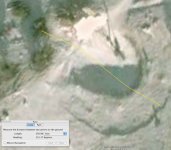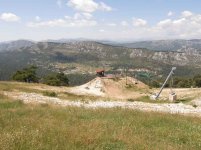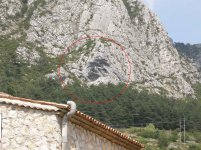Now I know that is an impossible question to answer... it all depends on trajectory, and the material it impacts... but I am researching a certain meteorite that fell in rocky, mountainous terrain. It was found hundreds of years ago, but the locals don't know exactly where... it weighs slightly over 1400 pounds and is about 3 feet by 2 feet. so I thought... hmm... I wonder if I could find a crater of some sort using Google Earth?
Here is a screen grab from Google Earth of the general area. Could this be a crater? It appears to have a radio or phone tower there now - but that SURE looks like an impact crater to me! It's at least 200 feet across.
What do YOU think? Could/would a 1400 pound meteor leave a crater that large (or even larger?)
I sure would like to find more pieces of that monstrous meteorite!
Thanks,
Marc
Here is a screen grab from Google Earth of the general area. Could this be a crater? It appears to have a radio or phone tower there now - but that SURE looks like an impact crater to me! It's at least 200 feet across.
What do YOU think? Could/would a 1400 pound meteor leave a crater that large (or even larger?)
I sure would like to find more pieces of that monstrous meteorite!
Thanks,
Marc







 Any luck on getting up to that spot behind the cabin?
Any luck on getting up to that spot behind the cabin?